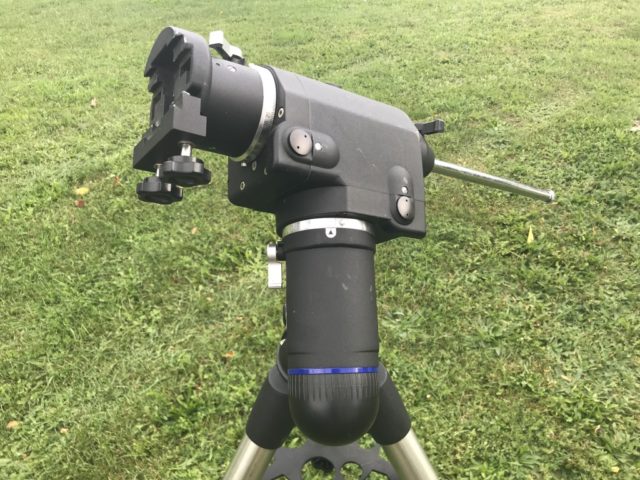Last Updated on February 23, 2024 by Practical Astrophotography Staff
Gazing up at the night sky, it’s impossible not to feel a sense of wonder and curiosity. For beginners venturing into the world of astronomy, a telescope can open up a whole new realm of exploration. But to truly unlock the universe’s secrets, one must navigate the night sky with precision. That’s where polar alignment comes into play.
Polar alignment is the process of aligning a telescope’s mount with the celestial pole, ensuring optimal performance and accuracy. Whether you’re a seasoned astronomer or just starting out, perfecting polar alignment can make a world of difference in your stargazing experience.
In this beginner’s guide, we’ll demystify the process of polar alignment, providing step-by-step instructions and insider tips to assist you along your astronomical journey. From understanding the basics of the celestial coordinate system to mastering the alignment techniques, you’ll gain the knowledge and confidence to capture breathtaking images of distant galaxies and nebulae.
Get ready to embark on an adventure through the cosmos as we help you master the art of polar alignment for optimal telescope performance. Let’s reach for the stars together.
Understanding polar alignment
Polar alignment is the process of aligning a telescope’s mount with the celestial pole, ensuring optimal performance and accuracy. By aligning the mount to the celestial pole, you align it with the Earth’s rotational axis, allowing for smooth tracking of celestial objects as they appear to move across the night sky. This alignment is crucial for capturing clear images and tracking objects accurately.
To understand polar alignment, it’s important to grasp the basics of the celestial coordinate system. The celestial sphere, an imaginary sphere surrounding the Earth, is divided into two halves: the northern celestial hemisphere and the southern celestial hemisphere. The celestial pole is the point in the sky directly above the Earth’s North or South Pole, depending on your location. For most beginners, aligning with the North Celestial Pole (NCP) is the usual practice.
The importance of polar alignment for telescope performance
Why is polar alignment so important for telescope performance? The simple answer lies in the Earth’s rotation. As the Earth rotates on its axis, celestial objects appear to move across the sky. If your telescope is not accurately aligned with the celestial pole, it will not track these objects smoothly. This can result in blurry images and frustration.
Achieving proper polar alignment ensures that your telescope’s tracking is aligned with the Earth’s rotation. This allows for longer exposures, sharper images, and better tracking of celestial objects. Whether you’re interested in astrophotography or simply observing distant galaxies and nebulae, polar alignment is crucial for maximizing your telescope’s performance.
Common challenges in polar alignment
Perfecting polar alignment can be a challenging task, especially for beginners. One common challenge is finding the celestial pole accurately. The NCP is not visible to the naked eye, so you’ll need to use other methods to locate it. Fortunately, there are several techniques and tools available to help you in this endeavor.
Another challenge is ensuring that your telescope’s mount is properly aligned with the celestial pole. This requires patience, precision, and practice. Even a small misalignment can have a significant impact on your telescope’s performance. However, with the right knowledge and techniques, you can overcome these challenges and achieve accurate polar alignment.
Tools and techniques for polar alignment
To aid in the process of polar alignment, there are various tools and techniques available. One commonly used tool is a polar alignment scope. This device fits into the mount’s polar axis and provides a reticle with markings to guide you in aligning with the celestial pole. Other tools, such as smartphone apps and computer software, can also assist in locating the celestial pole and aligning your telescope.
In addition to using tools, there are several techniques you can employ to achieve accurate polar alignment. One technique is the drift alignment method, which involves monitoring the drift of a star as it moves across the field of view. By adjusting your mount’s altitude and azimuth, you can minimize the drift and achieve alignment. Another technique is the polar alignment routine built into some telescope mounts, which uses a series of movements to calibrate the alignment.
Step-by-step guide to polar alignment
Now that you understand the importance of polar alignment and the tools and techniques available, let’s dive into a step-by-step guide to help you achieve accurate alignment.
1. Set up your telescope and mount in a suitable location with an unobstructed view of the sky.
2. Level your mount using a bubble level to ensure it is balanced.
3. Align your telescope roughly towards the North using a compass or by aligning with a landmark.
4. Use a polar alignment scope, smartphone app, or computer software to locate the celestial pole.
5. Adjust your mount’s altitude and azimuth to align with the celestial pole. Use the markings on your polar alignment scope or the guidance provided by the app or software.
6. Fine-tune the alignment by using the drift alignment method or the built-in polar alignment routine, depending on your mount’s capabilities.
7. Once you have achieved accurate alignment, tighten the mount’s locking mechanisms to secure the position.
Troubleshooting tips for polar alignment issues
Even with careful alignment, you may encounter issues that affect your telescope’s polar alignment. Here are some troubleshooting tips to help you overcome common problems:
1. If you are consistently off in your alignment, double-check your initial set-up and make sure your mount is level and balanced.
2. If you are experiencing drift during long exposures, check for any backlash in your mount’s gears and make adjustments as necessary.
3. If you are using a polar alignment scope, ensure that it is properly calibrated and aligned with your telescope’s optical axis.
4. If you are struggling to locate the celestial pole, try using multiple reference stars to triangulate its position.
Advanced techniques for precise polar alignment
Once you have mastered the basics of polar alignment, you may want to explore more advanced techniques for achieving even greater precision. One technique is using a drift alignment software, which analyzes the drift of stars in your images and provides precise adjustments for alignment. Another technique is using a guide camera and autoguiding system, which continuously adjusts your telescope’s tracking to compensate for any misalignment.
Best practices for maintaining polar alignment
Achieving accurate polar alignment is only the first step. To maintain alignment throughout your observing session, it’s important to follow some best practices:
1. Avoid bumping or moving your telescope once it is aligned. Even small movements can disrupt the alignment.
2. Check and adjust your alignment periodically, especially if you are observing for an extended period.
3. Keep an eye on your mount’s tracking accuracy and make any necessary adjustments.
4. Be mindful of any changes in temperature or wind conditions, as they can affect your telescope’s alignment.
Polar alignment software and apps
In the digital age, there are numerous software programs and smartphone apps available to assist with polar alignment. Some popular options include PolarFinder, PHD2 Guiding, PoleAlignMax, and AstroTortilla. These tools can help you locate the celestial pole, guide you through the alignment process, and provide valuable data to improve your alignment accuracy.
Conclusion
Embarking on a journey through the night sky can be an awe-inspiring experience. By mastering the art of polar alignment, you can enhance your telescope’s performance and unlock the wonders of the universe. Whether you’re a beginner or a seasoned astronomer, taking the time to perfect your polar alignment techniques will undoubtedly lead to more rewarding stargazing sessions and the ability to capture breathtaking images of distant galaxies and nebulae. So, grab your telescope, follow our step-by-step guide, and reach for the stars with confidence and precision. Happy stargazing!














